Sourdough Cinnamon Raisin Bagels
These sourdough cinnamon raisin bagels are soft and chewy. They’re lightly flavored with cinnamon and dotted with raisins.
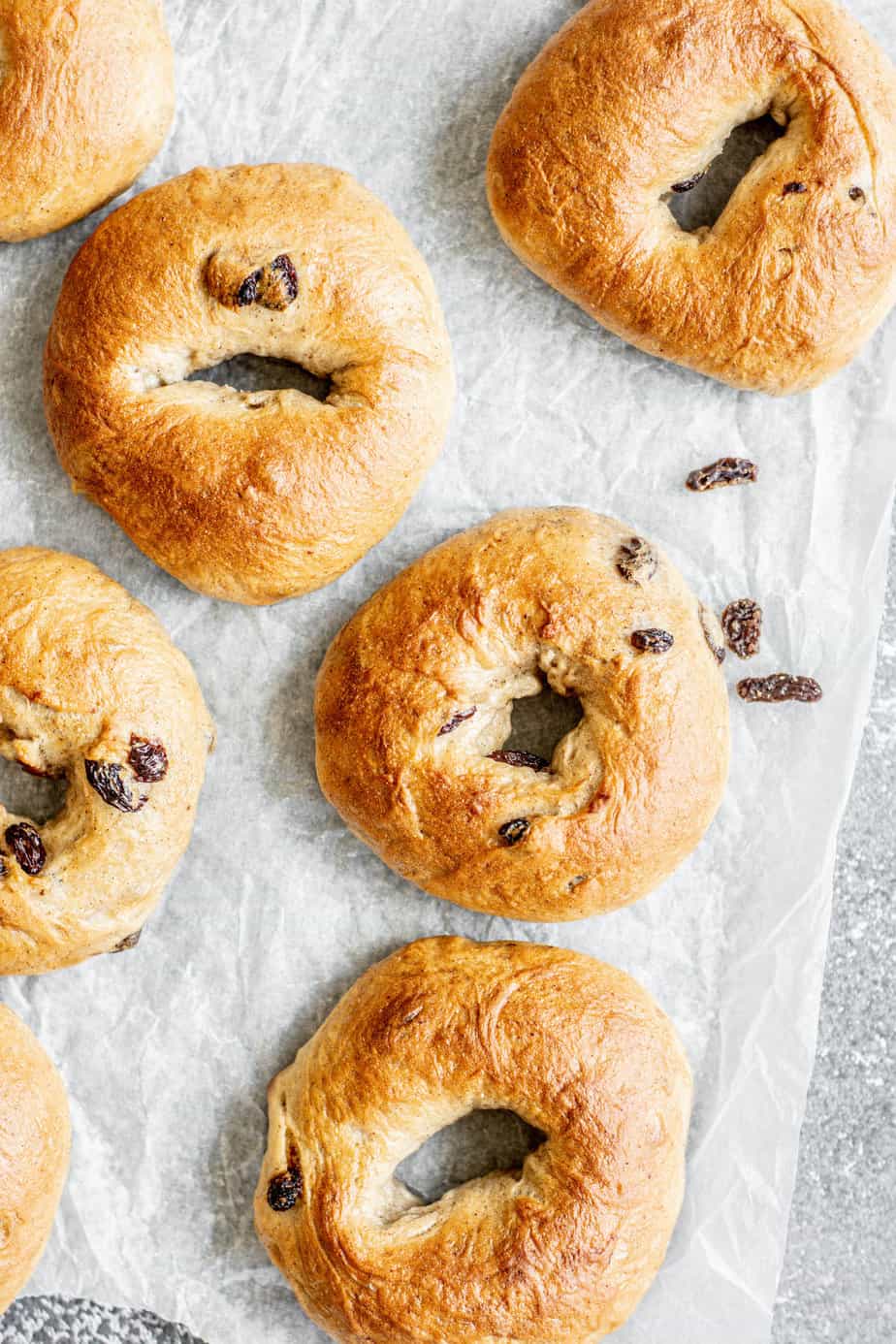
Sourdough bagels are easy to make, and they taste delicious. They’re risen using a sourdough starter which brings extra flavor and texture
Don’t have a sourdough starter yet to make this recipe? Check out my sourdough starter guide to prepare an active sourdough starter for baking!
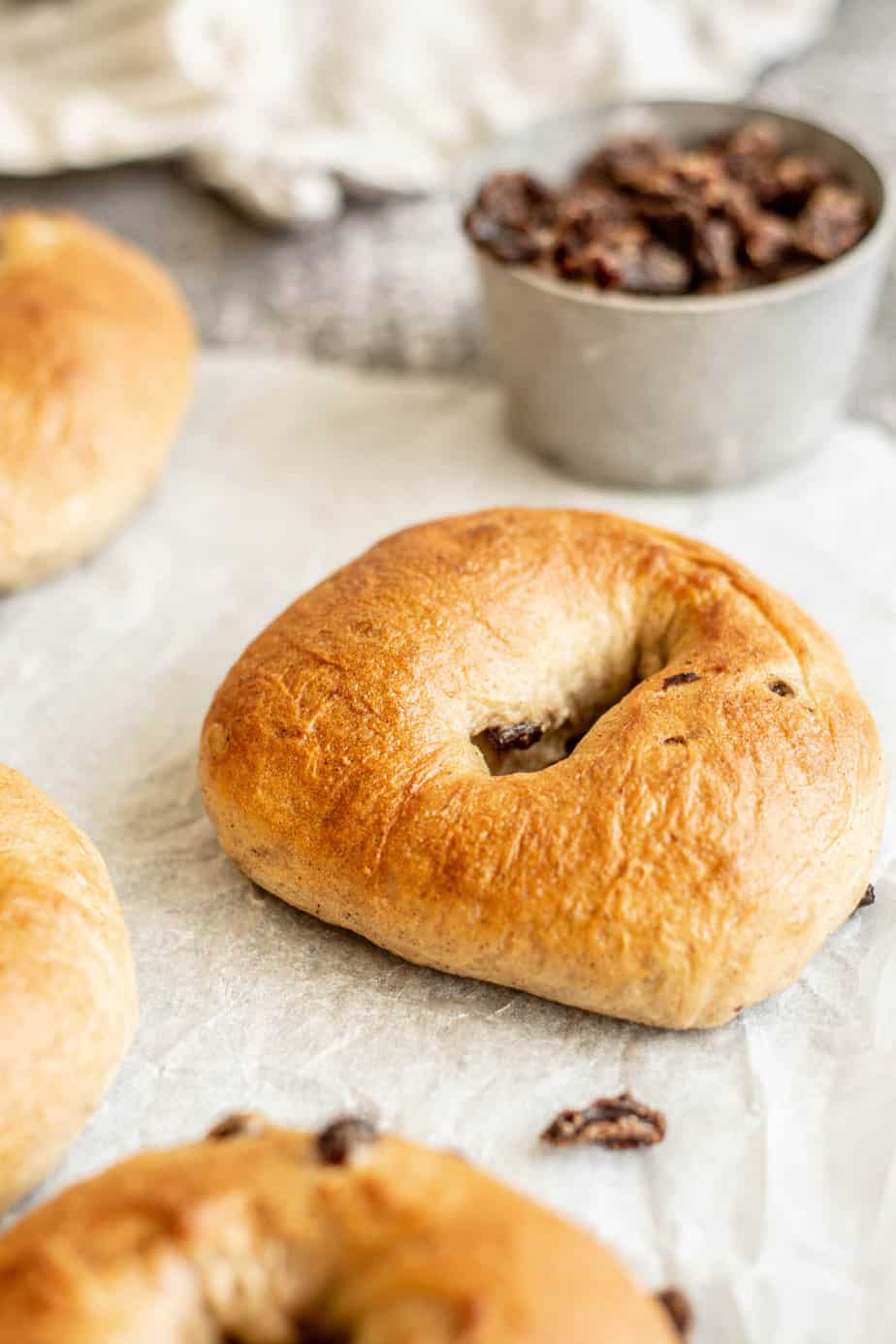
About these bagels
The bagel dough is lean and thick with low hydration (unlike many other sourdough recipes like sourdough brioche or cinnamon raisin bread).
This makes dense and chewy bagels with a wonderful toothsome texture. The dough is easy to knead by hand, or you can make it in the bowl of a stand mixer.
These sourdough bagels are made over two days. The dough undergoes two main rising periods, one at room temperature and one overnight in the refrigerator. The long cold proof brings extra flavor to the dough.
You can shorten the time by skipping the cold proof if you like. This will lessen the sourdough tang. After shaping, they are poached in boiling water before baking. This gives them that iconic chewy texture.
The ingredients
Find the simple ingredients for this sourdough bagel recipe listed in the printable recipe card at the bottom of this post. Here is a rundown of what you will need.
- Active sourdough starter
- Warm water
- Soft brown sugar
- Bread flour or strong all-purpose flour
- Salt
- Ground cinnamon – woody and warming cinnamon is a perfect bagel pairing.
- Raisins – Plump raisins add texture and sweetness.
- More brown sugar, honey or barley malt syrup to boil bagels – Poaching them in sweetened boiling water before baking gives them a golden and chewy crust. You can also in a touch of baking soda which will make them even more deeply browned.
Equipment
This sourdough recipe can easily be made by hand or use a stand mixer with a dough hook attachment.
Method
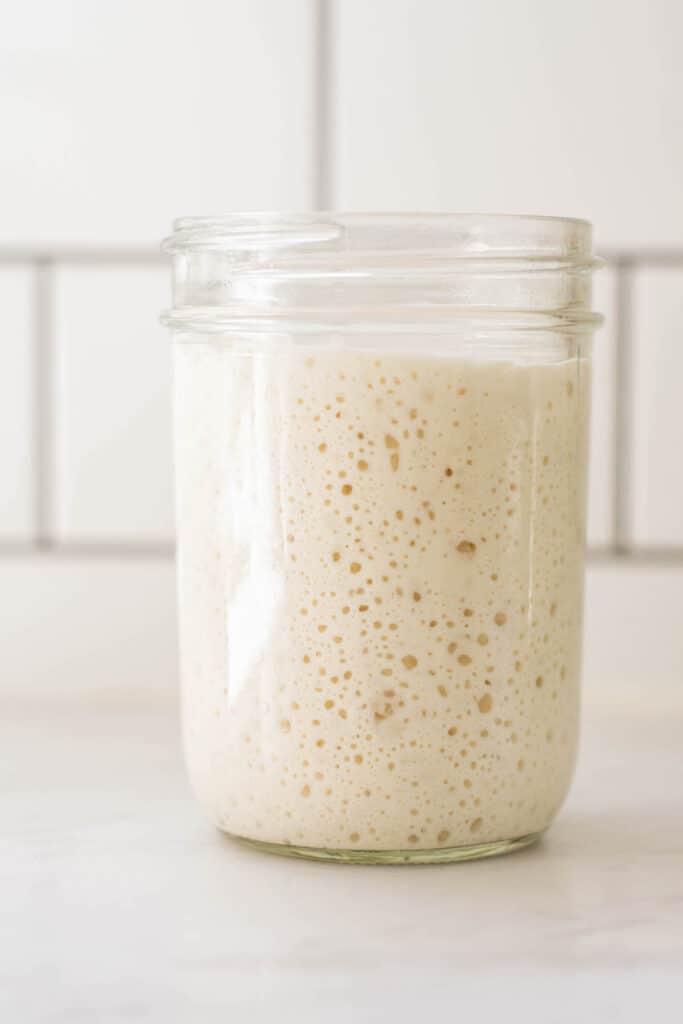
In the morning or the evening before, feed your sourdough starter. Let rise until doubled in size.
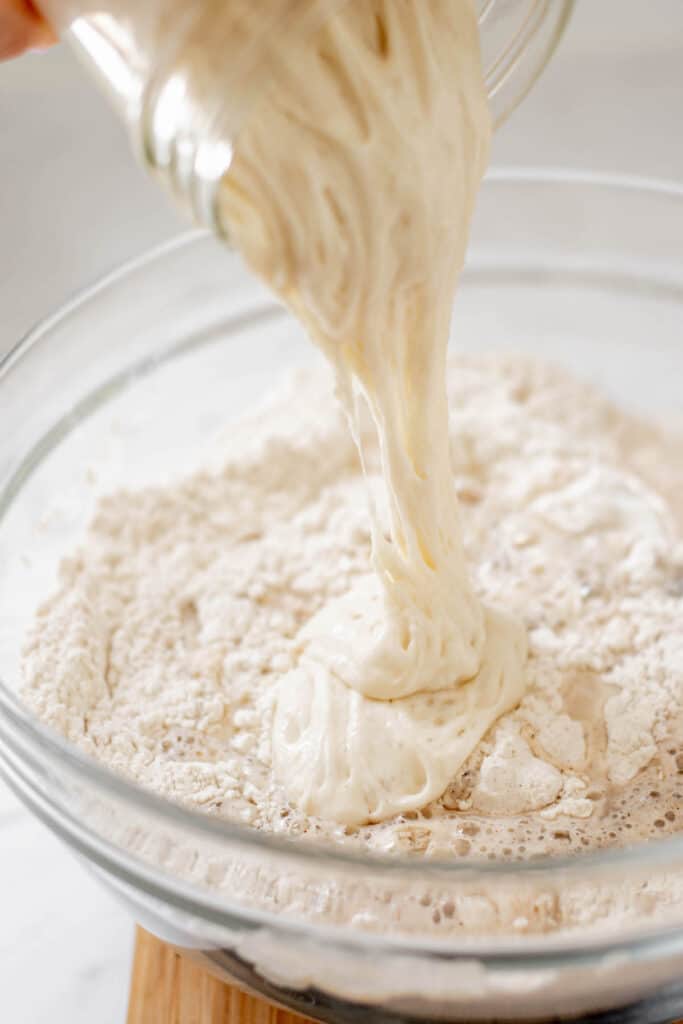
In a large bowl, add flour, cinnamon, brown sugar, salt and water. Add in the sourdough starter.
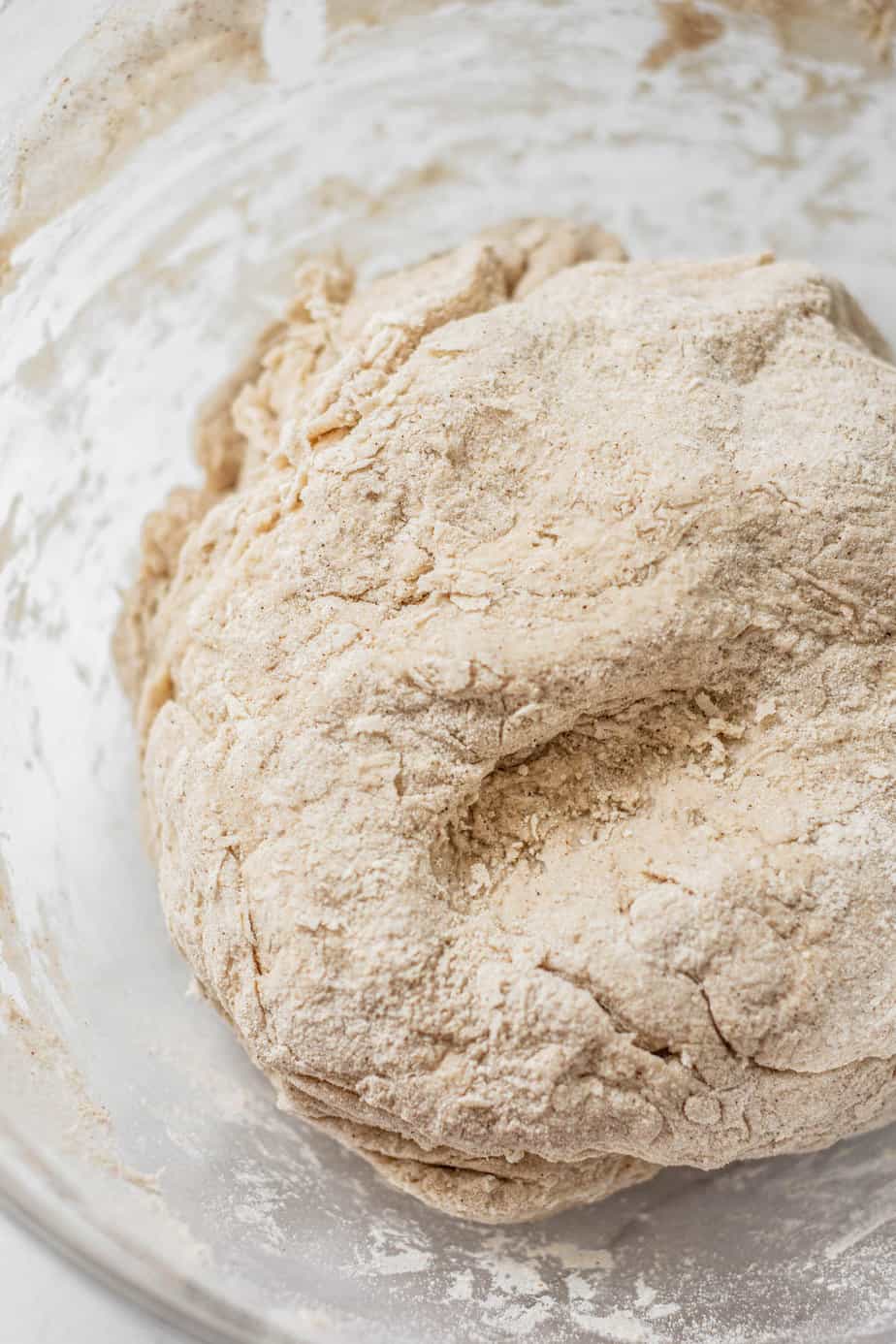
Use a fork and then your hands to mix the dough into rough and shaggy dough ball. Tip the dough onto a lightly floured surface and knead it until it is smooth.
The dough should be worked and kneaded for around 6-8 minutes for optimal gluten development. Alternatively, mix the dough in a bowl of a stand mixer fitted with a dough hook attachment on low speed.
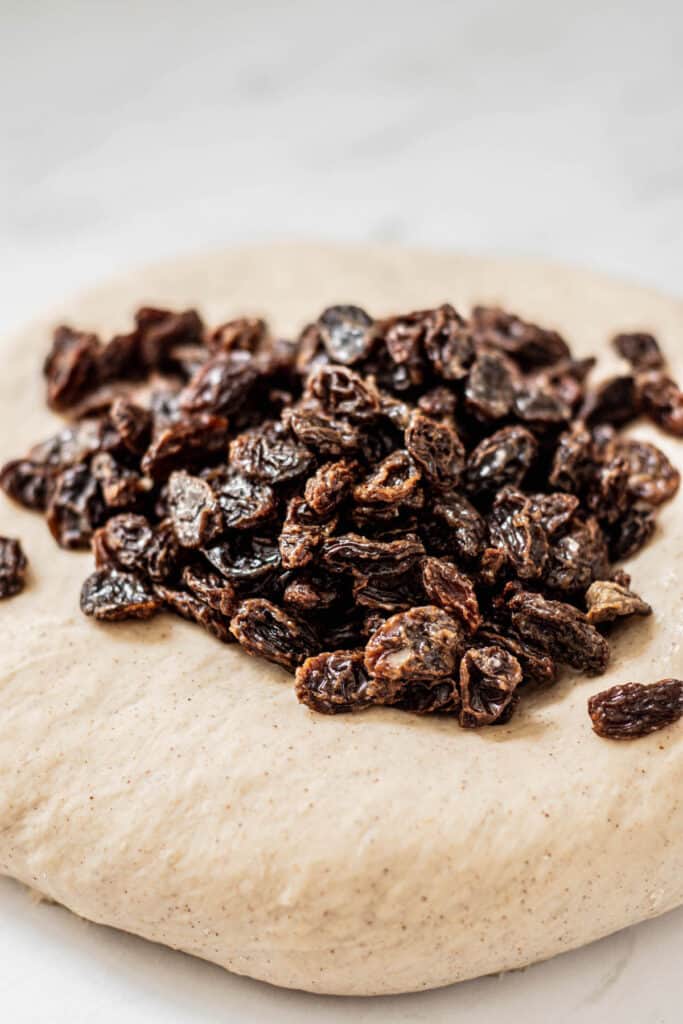
Press the dough into a flat disc and tip the raisins into the middle.
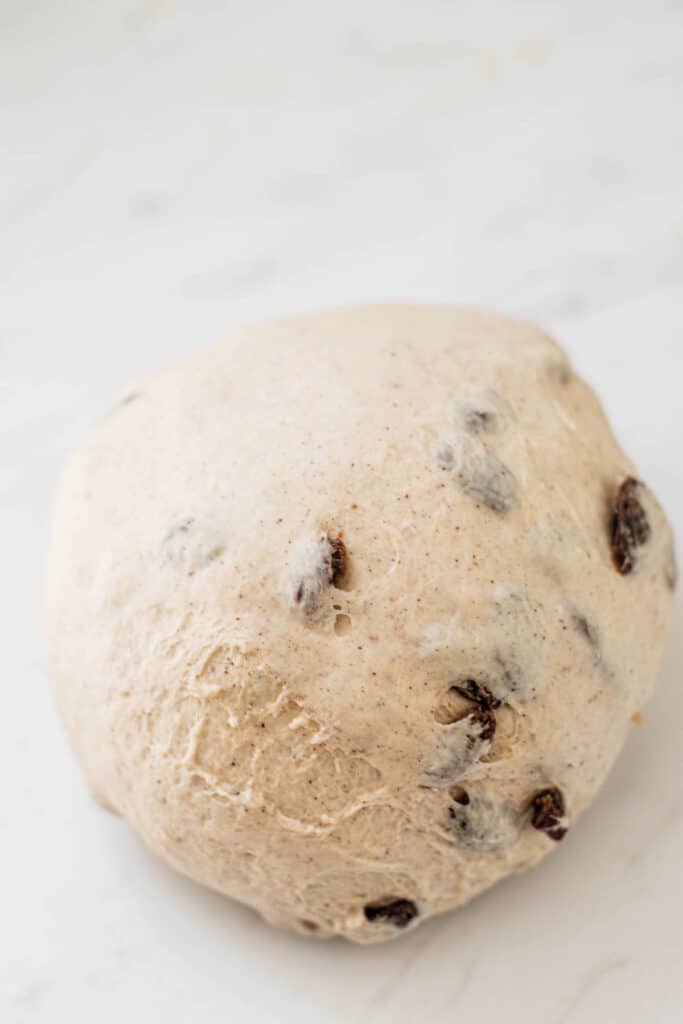
Gather the sides of the dough up to cover the raisins. Knead the dough again carefully to work in the raisins.
Once the raisins are incorporated, place the dough in a lightly greased large bowl, and cover the bowl with plastic wrap or a damp tea towel. Let the dough rise in a warm spot around 25°C/77°F until doubled in size.
You can create a warm and humid spot by placing the dough in a turned-off oven next to a mug of boiled water. This can take around 5-6 hours in a warm space.
Once the dough has risen, place it in the refrigerator until the next morning or for up to 24 hours. Alternatively, skip the cold proof and go right to shaping the bagels.
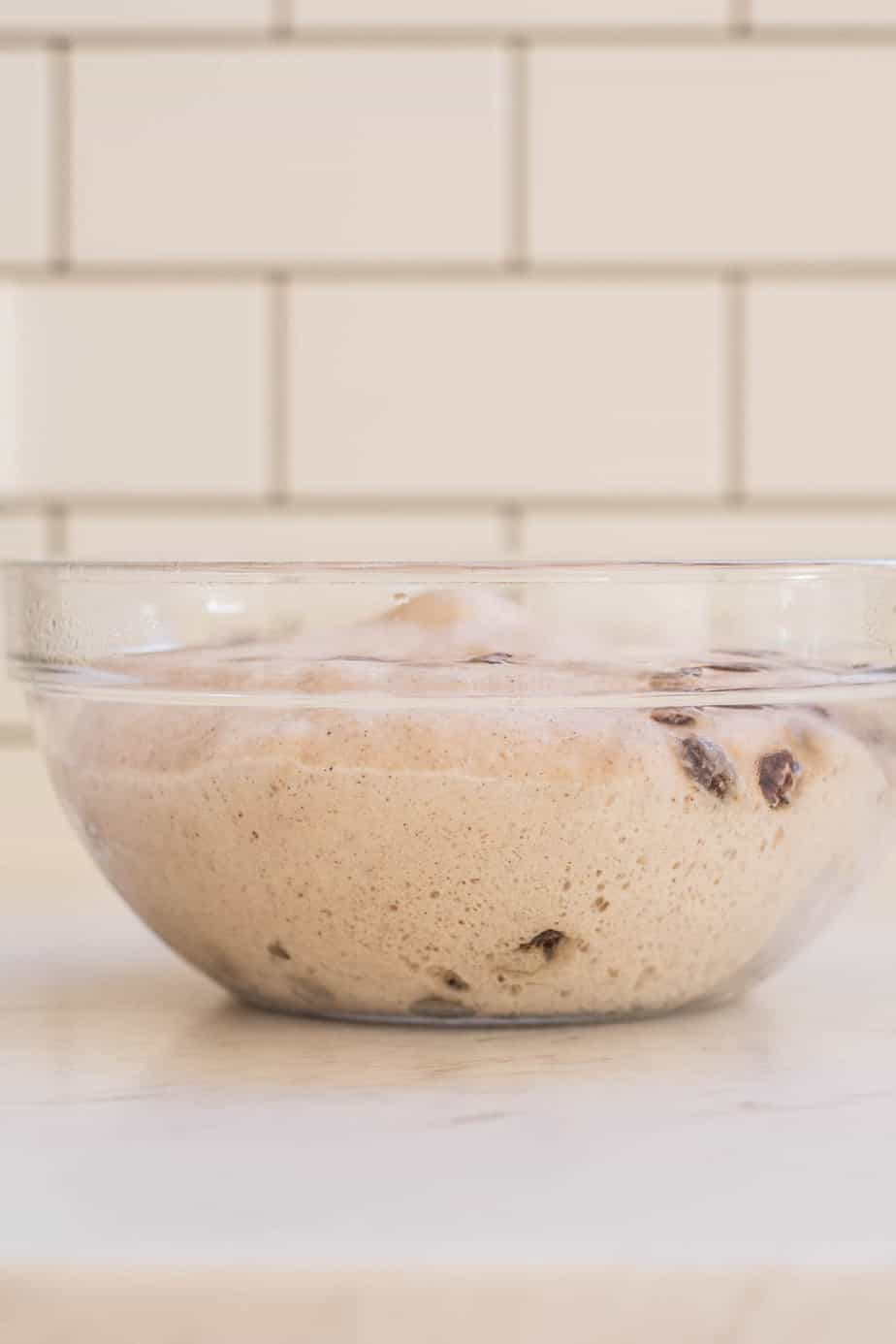
Shaping the bagels
Remove the stiff dough from the refrigerator and pull it from the bowl onto a lightly floured work surface.
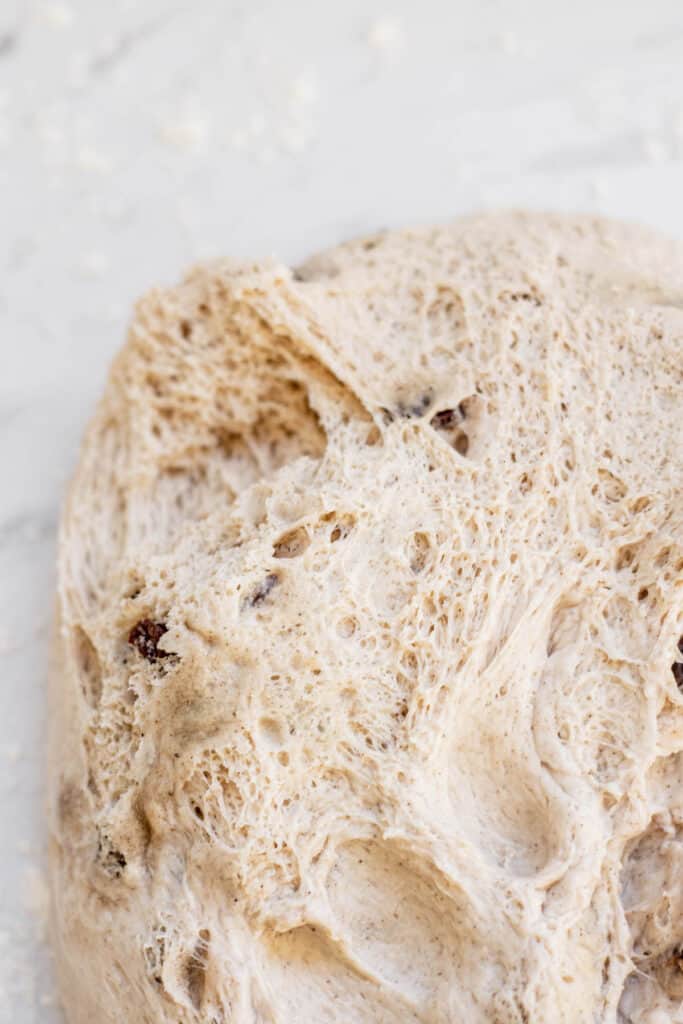
Use a bench scraper or sharp knife to cut the dough into nine equal portions.
A kitchen scale works well to ensure even bagels.

Shape each piece into a tight ball and rest them on a lightly floured work surface.
Let the dough rest for 10-15 minutes whilst the glutens relax.
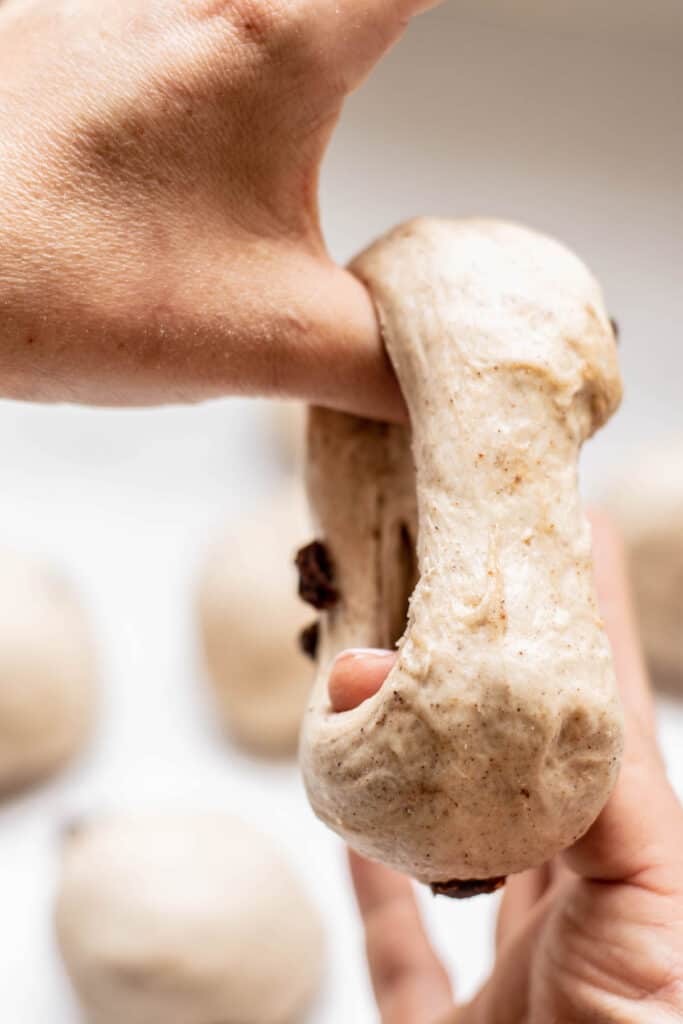
Take a ball of dough and use both hands’ thumb and index finger to push a hole into the center.
Roll the dough ball around your fingers in a circular motion to widen the hole.
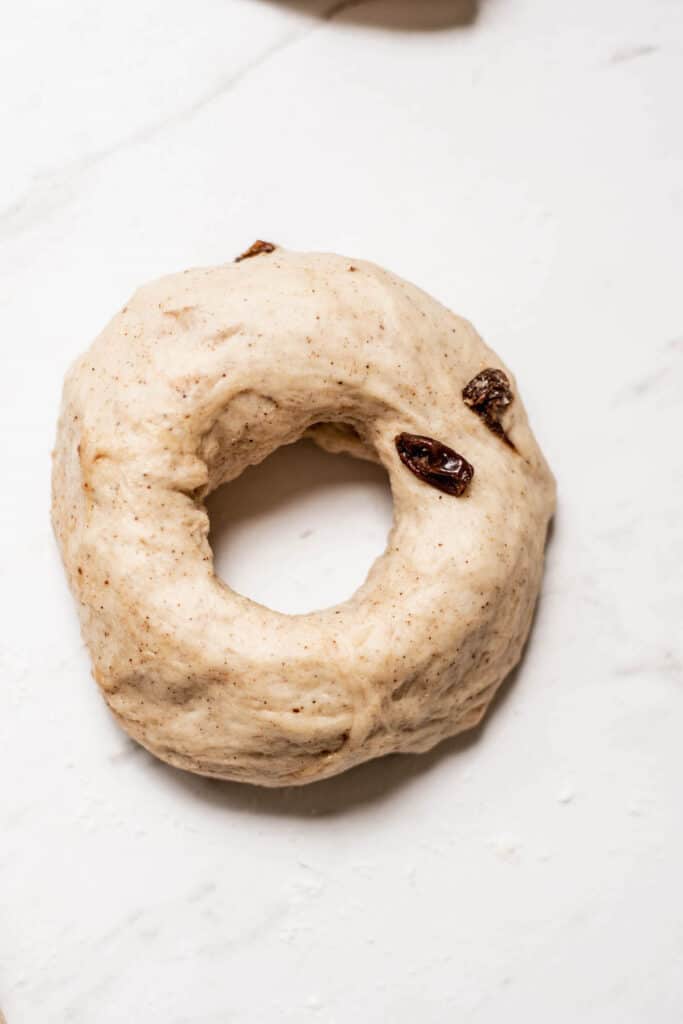
Aim for a large hole, as it will shrink back in size once it sits.
Continue with the rest of the dough balls.
Place the shaped bagels on a prepared sheet pan lined with parchment paper. Cover them with a dish towel and let them puff out for around 60 minutes while the oven preheats and a pot of water is brought to a boil.
Water bath
Bring a large pot of water to a boil, preheat the oven to 425°F/220°C, and line a large baking sheet with parchment paper.
Once the water is boiling, stir in brown sugar or honey.
Dust any excess flour off the bagels and drop them in the boiling water one at a time. Boil 2-3 bagels at a time.

Let them poach in the water for 1 minute in total, flipping them after 30 seconds.
Remove the bagels from the water using a slotted spoon. Drain the boiled bagels on a wire rack and continue with the rest.
Baking
Place the bagels on the lined baking sheet. Bake them in the oven for 22-25 minutes until a deep golden brown. If they are baking unevenly or your oven has hot spots, turn the oven tray around after 15 minutes of baking.
Remove the baked bagels from the tray and let them cool to room temperature on a cooling rack for 30 minutes before slicing and serving.
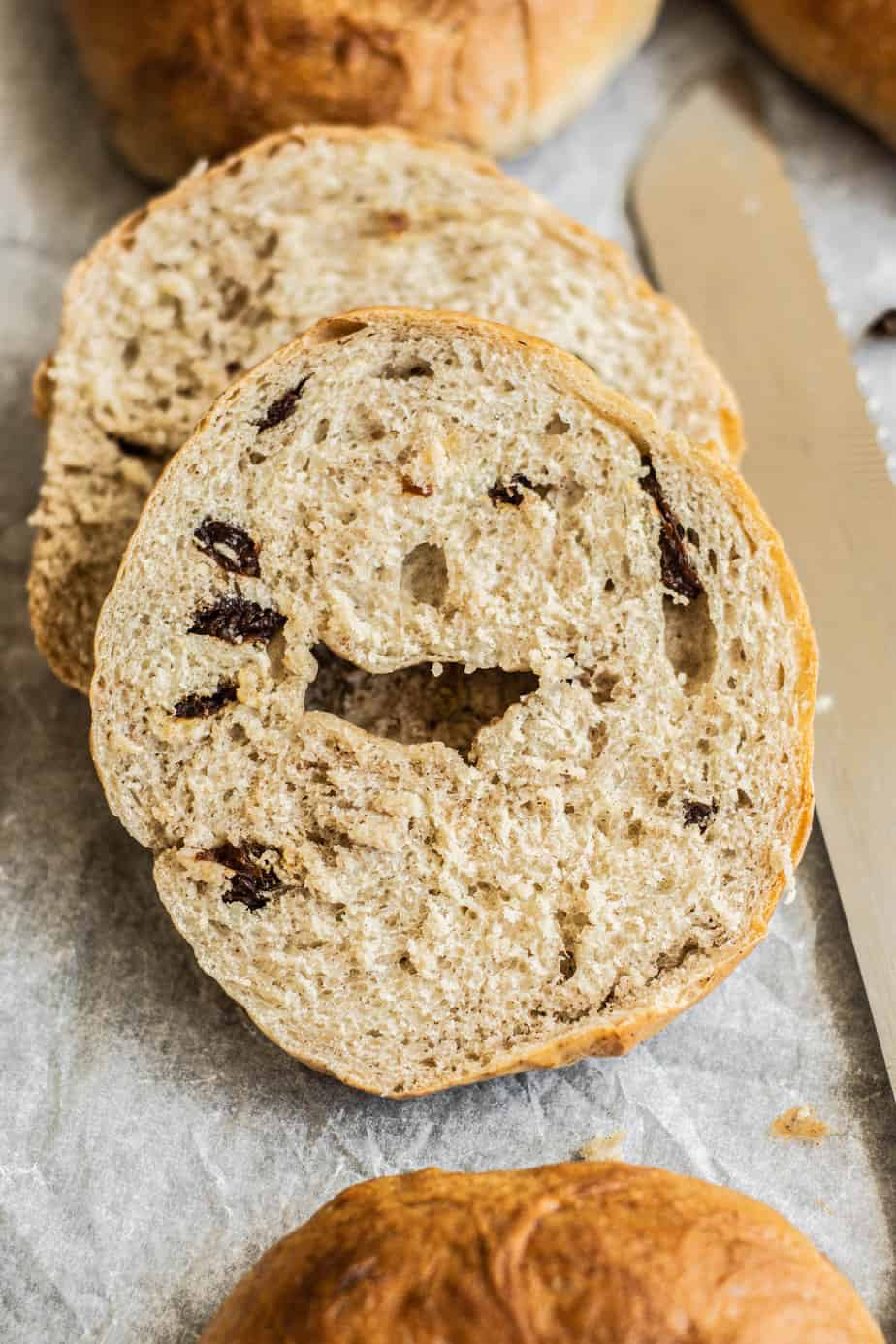
Serving and storing
Serve the bagels with a smear of cream cheese, or toast them and spread with salted butter.
Store leftover bagels in an airtight container for up to 3 days at room temperature. Sourdough cinnamon raisin bagels freeze very well, too. Freeze for up to 3 months.

Sourdough Cinnamon Raisin Bagels
These sourdough cinnamon raisin bagels are soft and chewy. They're lightly flavored with cinnamon and dotted with raisins.
Ingredients
Sourdough starter
- 40g starter
- 40g all-purpose flour
- 40g water
Dough
- 440g strong all-purpose flour or bread flour, with a protein level of at least 11%*
- 240g water
- All the sourdough starter (around 100g)
- 12g brown sugar
- 1 1/2 tsp ground cinnamon
- 1 1/2 tsp salt
- 80g raisins
Poaching
- 2L water
- 1 heaped Tablespoon of honey or brown sugar
Instructions
- In the morning, feed your sourdough starter. Add it to a clean jar and cover it with a cloth. Let it rise in a warm spot until doubled in size.
- Once the starter is ready, add it to a large mixing bowl with the rest of the dough ingredients and use a fork to combine it into a thick and rough dough.
- Tip the dough onto a lightly floured surface and knead it until it is smooth. The dough should be worked and kneaded for around 6-8 minutes for optimal gluten development. Alternatively, mix the dough in a bowl of a stand mixer fitted with a dough hook attachment on low speed.
- Press the dough into a flat disc and tip the raisins into the middle. Gather the sides of the dough up to cover the raisins, then knead the dough again carefully to work the raisins into the dough.
- Once the raisins are incorporated, place the dough in a lightly greased large bowl, and cover the bowl with plastic wrap or a damp tea towel. Let the dough rise in a warm spot around 25°C/77°F until doubled in size. You can create a warm and humid spot by placing the dough in a turned-off oven next to a mug of boiled water. This can take around 5-6 hours in a warm space.
- Once the dough has risen, place it in the refrigerator until the next morning or for up to 24 hours. Alternatively, skip the cold proof and go right to shaping the bagels.
Shaping the bagels
- Remove the stiff dough from the refrigerator and pull it from the bowl onto a lightly floured work surface.
- Use a bench scraper or sharp knife to cut the dough into nine equal portions. A kitchen scale works well to ensure even bagels. Shape each piece into a tight ball and rest them on a lightly floured work surface. Let the dough rest for 10-15 minutes whilst the glutens relax.
- Take a ball of dough and use both hands' thumb and index finger to push a hole into the center, then roll the dough ball around your fingers in a circular motion to widen the hole. Aim for a large hole, as it will shrink back in size once it sits. Continue with the rest of the dough balls.
- Place the shaped bagels on a prepared sheet pan lined with parchment paper and let them puff out for around 60 minutes while the oven preheats and a pot of water is brought to a boil.
Water bath
- Preheat the oven to 220°C/425°F, and line a large baking sheet with parchment paper. Bring a large pot of water to a boil.
- Once boiling, stir in brown sugar or honey.
- Dust any excess flour off the bagels and drop them in the boiling water one at a time. Boil 2-3 bagels at a time.
- Let them poach in the water for 1 minute in total, flipping them after 30 seconds. Remove the bagels from the water using a slotted spoon. Drain the boiled bagels on a wire rack and continue with the rest.
Baking
- Place the bagels on the lined baking sheet. Bake them in the oven for 22-25 minutes until a deep golden brown. If they are baking unevenly or your oven has hot spots, turn the oven tray around after 15 minutes of baking.
- Remove the baked bagels from the tray and let them cool to room temperature on a cooling rack for 30 minutes before slicing and serving.
Nutrition Information:
Yield: 9 Serving Size: 1Amount Per Serving: Calories: 351Total Fat: 1gSaturated Fat: 0gTrans Fat: 0gUnsaturated Fat: 1gCholesterol: 1mgSodium: 407mgCarbohydrates: 73gFiber: 3gSugar: 9gProtein: 12g





